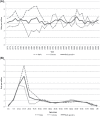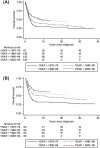Time-trends on incidence and survival in a nationwide and unselected cohort of patients with skeletal osteosarcoma
- PMID: 24957555
- PMCID: PMC4364276
- DOI: 10.3109/0284186X.2014.923934
Time-trends on incidence and survival in a nationwide and unselected cohort of patients with skeletal osteosarcoma
Abstract
Background: This study describes time-trends on epidemiology, subtypes and histopathological entities of osteosarcoma (OS) in a nationwide and unselected cohort of OS patients in Norway between 1975 and 2009. Few nationwide studies are published, and we still have particularly limited knowledge regarding patients not included in clinical trials comprising about half of the OS population.
Method: Histologically verified skeletal OS for all subgroups were included, resulting in 473 eligible cases from a total of 702 evaluated patients. To ensure completeness, the present cohort was based on all cases reported to the Norwegian Cancer Registry, complemented with data from all Norwegian hospitals involved in sarcoma management. Survival analyses were performed with overall and sarcoma-specific survival as endpoints.
Results: Mean annual age-standard incidence amounted to about 3.8 per million in male and 2.8 per million in female with no clear time-trends. The male to female ratio was 1.4. Peak incidence was observed in the second decade for both genders. Conventional OS comprised 71.2% of all cases, while low grade OS represented 10.4% and telangiectatic OS only 1.3%. The most common primary site of OS was femur and tibia, respectively. The axial to appendicular ratio increased with the age. The overall 10-year survival did increase from about 30% during the late 1970s to around 50% 20 years later, with no subsequent improvement during the last two decades. Axial tumours, age above 40 years and overt metastatic disease at time of diagnosis were all negative prognostic factors.
Conclusion: No improvement in the overall survival for OS since the 1990s was documented. The survival rates are still poor for elderly people, patients with axial disease and in the primary metastatic setting. The average incidence rate of skeletal OS in Norway was in line with international figures.
Figures




References
-
- Unni KK, Inwards CY. Dahlinś bone tumors. 6th ed. Philadelphia: Lippincott Williams & Wilkins; 2010.
-
- Huvos AG. Bone tumors. Diagnosis, treatment and prognosis. 2nd ed. Philadelphia: W.B. Saunders; 1991.
-
- Fletcher CDM, Bridge JA, Hogendoorn PCW, Mertens F. WHO classification of tumours of soft tissue and bone. 4th ed. Lyon: International Agency for Research on Cancer; 2013.
-
- Bruland OS, Pihl A. On the current management of osteosarcoma. A critical evaluation and a proposal for a modified treatment strategy. Eur J Cancer. 1997;33:1725–31. - PubMed
Publication types
MeSH terms
LinkOut - more resources
Full Text Sources
Other Literature Sources
Medical
